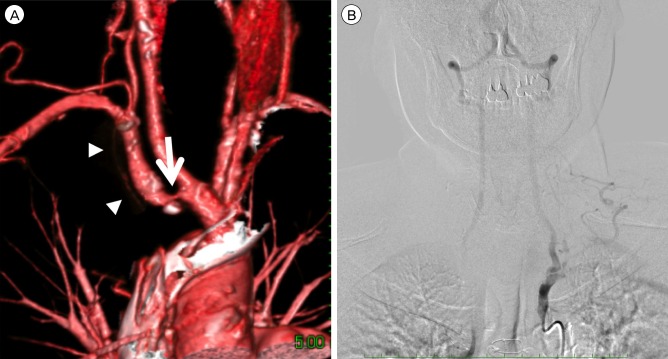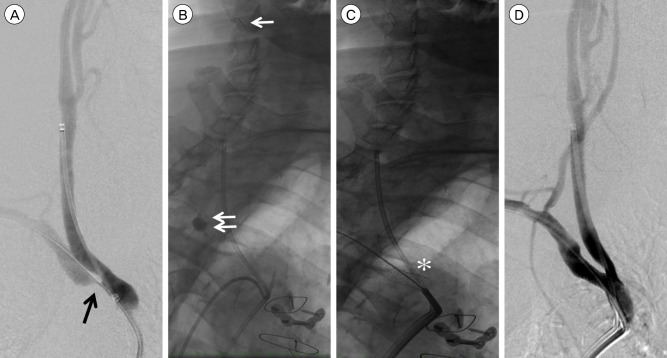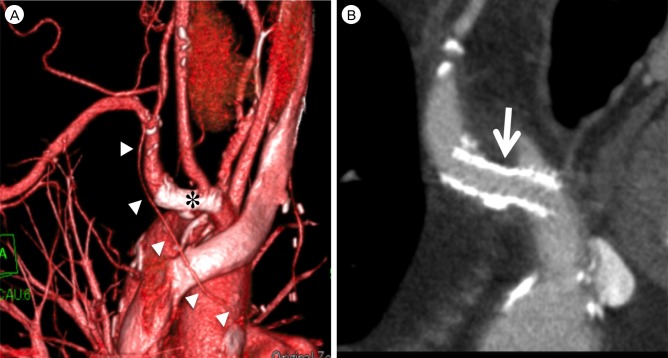J Cerebrovasc Endovasc Neurosurg.
2015 Mar;17(1):27-31. 10.7461/jcen.2015.17.1.27.
Endovascular Stenting under Cardiac and Cerebral Protection for Subclavian Steal after Coronary Artery Bypass Grafting Due to Right Subclavian Artery Origin Stenosis
- Affiliations
-
- 1Department of Neurosurgery, Hiroshima University Graduate School of Biomedical and Health Sciences, 1-2-3 Kasumi, Minami-ku, Hiroshima, Japan. sakamoto@hiroshima-u.ac.jp
- KMID: 1963146
- DOI: http://doi.org/10.7461/jcen.2015.17.1.27
Abstract
- Coronary-subclavian steal (CSS) can occur after coronary artery bypass grafting (CABG) using the internal thoracic artery (ITA). Subclavian artery (SA) stenosis proximal to the ITA graft causes CSS. We describe a technique for cardiac and cerebral protection during endovascular stenting for CSS due to right SA origin stenosis after CABG. A 64-year-old man with a history of CABG using the right ITA presented with exertional right arm claudication. Angiogram showed a CSS and retrograde blood flow in the right vertebral artery (VA) due to severe stenosis of the right SA origin. Endovascular treatment of the right SA stenosis was planned. For cardiac and cerebral protection, distal balloon protection by inflating a 5.2-F occlusion balloon catheter in the SA proximal to the origin of the right VA and ITA through the right brachial artery approach and distal filter protection of the right internal carotid artery (ICA) through the left femoral artery (FA) approach were performed. Endovascular stenting for SA stenosis from the right FA approach was performed under cardiac and cerebral protection by filter-protection of the ICA and balloon-protection of the VA and ITA. Successful treatment of SA severe stenosis was achieved with no complications.
MeSH Terms
Figure
Reference
-
1. Albuquerque FC, Ahmed A, Mitha A, Stiefel M, McDougall CG. Endovascular recanalization of the chronically occluded brachiocephalic and subclavian arteries: technical considerations and an argument for embolic protection. World Neurosurg. 2013; 12. 80(6):e327–e336. PMID: 23043999.
Article2. Bicknell CD, Subramanian A, Wolfe JH. Coronary subclavian steal syndrome. Eur J Vasc Endovasc Surg. 2004; 2. 27(2):220–221. PMID: 14718907.
Article3. Guimaraes M, Muhlert MK, Enterkin J, Schonholz C. Can we provide complete cerebral protection during innominate artery stenting? J Endovasc Ther. 2010; 10. 17(5):657–659. PMID: 20939726.4. Harjola PT, Valle M. The importance of aortic arch or subclavian angiography before coronary reconstruction. Chest. 1974; 10. 66(4):436–438. PMID: 4416304.
Article5. Lobato EB, Kern KB, Bauder-Heit J, Hughes L, Sulek CA. Incidence of coronary-subclavian steal syndrome in patients undergoing noncardiac surgery. J Cardiothorac Vasc Anesth. 2001; 12. 15(6):689–692. PMID: 11748514.
Article6. Machado C, Raposo L, Leal S, Goncalves PA, Mesquita Gabriel H, Teles RC, et al. Coronary-subclavian steal syndrome: percutaneous approach. Case Rep Cardiol. 2013; 2013:757423. PMID: 24829810.
Article7. Michael TT, Banerjee S, Brilakis E. Subclavian artery intervention with vertebral embolic protection. Catheter Cardiovasc Interv. 2009; 7. 74(1):22–25. PMID: 19530179.
Article8. Miyakoshi A, Hatano T, Tsukahara T, Murakami M, Arai D, Yamaguchi S. Percutaneous transluminal angioplasty for atherosclerotic stenosis of the subclavian or innominate artery: angiographic and clinical outcomes in 36 patients. Neurosurg Rev. 2012; 1. 35(1):121–125. discussion 125-6. PMID: 21643683.
Article9. Ringelstein EB, Zeumer H. Delayed reversal of vertebral artery blood flow following percutaneous transluminal angioplasty for subclavian steal syndrome. Neuroradiology. 1984; 26(3):189–198. PMID: 6234477.
Article10. Sadek MM, Ravindran A, Marcuzzi DW, Chisholm RJ. Complete occlusion of the proximal subclavian artery post-CABG: presentation and treatment. Can J Cardiol. 2008; 7. 24(7):591–592. PMID: 18612504.
Article11. Sakamoto S, Kiura Y, Kajihara Y, Mukada K, Kurisu K. Endovascular stenting of symptomatic innominate artery stenosis under distal balloon protection of the internal carotid and vertebral artery for cerebral protection: a technical case report. Acta Neurochir (Wien). 013; 2. 155(2):277–280. PMID: 23263481.
Article12. Shah N, Nee LM, Raval AN. Percutaneous revascularization of subclavian artery chronic occlusion with dual cerebral artery protection. Catheter Cardiovasc Interv. 2008; 6. 71(7):992–994. PMID: 18383148.
Article13. Tortoledo F, Sánchez A, Izaguirre L, Guerrero J, Trujillo MH. Endovascular repair of symptomatic coronary-subclavian steal syndrome due to stenosis of the proximal left subclavian artery. Cardiol Rev. 2005; May-Jun. 13(3):128–129. PMID: 15831145.
Article
- Full Text Links
- Actions
-
Cited
- CITED
-
- Close
- Share
- Similar articles
-
- A Hybrid Procedure for Coronary Artery Disease with Left Subclavian Artery Stenosis
- Recurrence of Coronary-Subclavian Steal Syndrome After Successful Angioplasty of Malfunctioning Arteriovenous Fistula
- Left Carotid-to-Subclavian Artery Bypass Grafting for Recurrent Angina Caused by Coronary-Subclavian Steal Syndrome
- Endovascular Therapy of Left Subclavian Artery Stenosis in Patients with Left Internal Mammary-Coronary Artery Bypass Graft
- Subclavian Artery Stenosis and Malfunction of Axillobifemoral Bypass Graft: A case report




